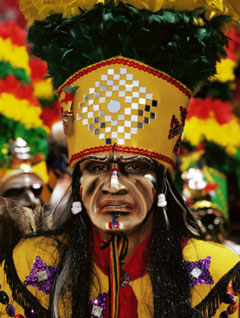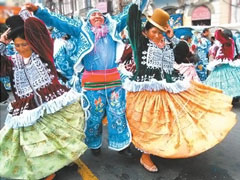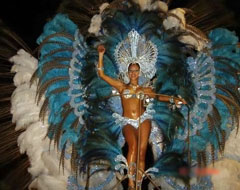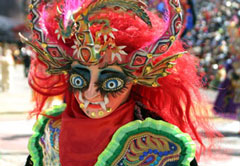 Carnaval, or Mardi Gras, in Bolivia is one of the most highly anticipated festivals of the year. People gather comparsas or fraternities together to organize different types of music and folkloric dance so that they can participate in parades and festivities that last several days.
Carnaval, or Mardi Gras, in Bolivia is one of the most highly anticipated festivals of the year. People gather comparsas or fraternities together to organize different types of music and folkloric dance so that they can participate in parades and festivities that last several days.
The festivities begin two weeks before Carnaval; for example, in some parts of the country, the first one is Compadres Thursday, and the next Thursday, which is the last one before Carnaval, is Comadres Thursday. (The terms Compadres and comadres usually refer to godfathers and godmothers, respectively, but for these occasions they are your best male or female friends, respectively.)
Let's take an imaginary trip through some Bolivian cities to get an idea of what this festival means in this country.
 Friday, the day before the parade in the city of La Paz, the current seat of government, people celebrate by making ritual offerings, called Ch'alla, at their workplaces to the Mother Earth, or Pachamama. That same Friday evening everyone gets ready for a long party weekend. Popular parades go through the city to celebrate Carnaval. The main characters represented in the parades are the Chutas, the Pepino, Kusillos and Morenos. These personalities are caricatures from the Colonial era. Carnaval in La Paz is celebrated by people of all ages, and children and teenagers play in the street throwing water at passersby, a custom which has been reduced thanks to water-conservation campaigns. Tuesday, after the last parade, another Ch'alla ritual is conducted, but this time by each family in its own home.
Friday, the day before the parade in the city of La Paz, the current seat of government, people celebrate by making ritual offerings, called Ch'alla, at their workplaces to the Mother Earth, or Pachamama. That same Friday evening everyone gets ready for a long party weekend. Popular parades go through the city to celebrate Carnaval. The main characters represented in the parades are the Chutas, the Pepino, Kusillos and Morenos. These personalities are caricatures from the Colonial era. Carnaval in La Paz is celebrated by people of all ages, and children and teenagers play in the street throwing water at passersby, a custom which has been reduced thanks to water-conservation campaigns. Tuesday, after the last parade, another Ch'alla ritual is conducted, but this time by each family in its own home.
Carnaval in Potosí is mainly celebrated by miners who march from the mine at the Cerro Rico (Rich Mountain) of Potosí. Carnaval is also known as the Miners' Carnaval, or Tata K'ajchu in Quechua (an indigenous language of the region). Miners perform different dances typical of the region until they reach the main plaza of the highest city in the world at 4,070 meters above sea level.
 Santa Cruz de la Sierra is the economic capital of the country, and Carnaval here is similar to the Carnaval in Rio de Janeiro, Brazil, in the sense that the comparsas compete to win first prize. Three Carnaval queens are elected every year: a girl, a woman and a grandmother. Entire floats are decorated for the parade that extend several meters above the heads of the dancers, and people wear fantastic dresses. On Ash Wednesday and throughout Carnaval week one can see concerts and plays on open-air stages in the city.
Santa Cruz de la Sierra is the economic capital of the country, and Carnaval here is similar to the Carnaval in Rio de Janeiro, Brazil, in the sense that the comparsas compete to win first prize. Three Carnaval queens are elected every year: a girl, a woman and a grandmother. Entire floats are decorated for the parade that extend several meters above the heads of the dancers, and people wear fantastic dresses. On Ash Wednesday and throughout Carnaval week one can see concerts and plays on open-air stages in the city.
The Carnaval celebration in Tarija is unique. It is celebrated two weeks prior with the Compadres and Comadres parties. People go through the streets during these festivals bearing baskets containing pastry made with seasonal fruits, streamers, flowers, cheese and balloons. The basket recipient becomes the compadre or comadre of the person who gave it and promises to be with the giver in both good times and bad, as a loyal friend. On Carnaval night, women dance with their cakes in the main plaza, where there is a dance contest and peasant music is played.
 Of course, the Carnaval of Oruro is the most famous in Bolivia, recognized by UNESCO as Intangible Cultural Heritage of humanity since 2008. The city works on preparations throughout the year to accommodate the thousands of visitors, including participants and spectators who arrive during Carnaval weekend. Every year there are around 28,000 dancers in the parade, 10,000 musicians and at least 400,000 spectators. Each dance group parades over the 4-km route, "walking" on their knees at the end to enter the church of the Virgin of the Cave at the Mine where there is a route into the mine. Participants dance and sing for this Virgin to which they promise to fulfill a vow. During this amazing parade that can last as long as 48 hours, we can see dances from throughout Bolivia, from the Amazons to the Altiplano of the Andes and the Chaco desert. The most famous dances are the Morenada, Tobas, Tinkus and Caporales, but the most famous of all is the Diablada which is an indigenous dance from the city of Oruro. If you are in Bolivia during Carnaval, be sure to attend this extraordinary event which is full of color and a festive atmosphere.
Of course, the Carnaval of Oruro is the most famous in Bolivia, recognized by UNESCO as Intangible Cultural Heritage of humanity since 2008. The city works on preparations throughout the year to accommodate the thousands of visitors, including participants and spectators who arrive during Carnaval weekend. Every year there are around 28,000 dancers in the parade, 10,000 musicians and at least 400,000 spectators. Each dance group parades over the 4-km route, "walking" on their knees at the end to enter the church of the Virgin of the Cave at the Mine where there is a route into the mine. Participants dance and sing for this Virgin to which they promise to fulfill a vow. During this amazing parade that can last as long as 48 hours, we can see dances from throughout Bolivia, from the Amazons to the Altiplano of the Andes and the Chaco desert. The most famous dances are the Morenada, Tobas, Tinkus and Caporales, but the most famous of all is the Diablada which is an indigenous dance from the city of Oruro. If you are in Bolivia during Carnaval, be sure to attend this extraordinary event which is full of color and a festive atmosphere.
After this short summary - you may choose whichever Carnaval that suits your fancy!


